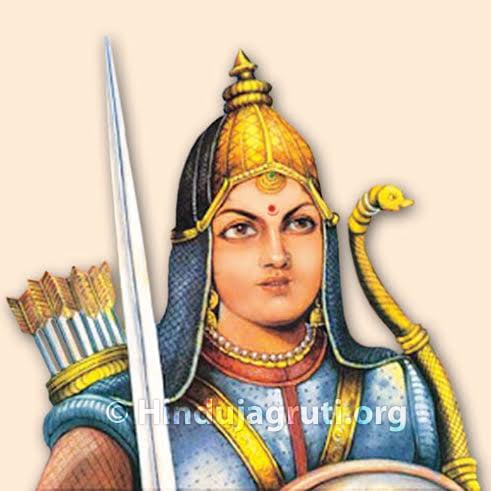RANI DURGAVATI
1. Context
Prime Minister Narendra Modi Laid the foundation stone of the Veerangana Rani Duragavati Memorial and Garden
The Project is dedicated to the 16th-century Gondwana Kingdom queen
2. Who was Rani Durgavati?
- Rani Durgavati (5 October 1524 – 24 June 1564) was the ruling Queen of Gondwana from 1550 until 1564. Rani Durgavati was a prominent Indian queen who ruled over the Gondwana Kingdom in central India during the 16th century. She is remembered for her valor, bravery, and her determined resistance against foreign invaders
- Rani Durgavati was born in 1524 in the family of Chandela Rajputs. She married Raja Dalpat Shah, the ruler of the Gondwana Kingdom, which was located in present-day Madhya Pradesh, India.
- After her husband's death in 1548, Rani Durgavati became the queen and ruled in the name of her young son, Raja Vir Narayan
- One of the most significant events in her life was her confrontation with the Mughal Emperor Akbar.

Image Source: Hindu Janajagruti Samiti
3.Mughal attack on Garha-Katanga
- The Mughal attack on Garha-Katanga was a military campaign launched by the Mughal Emperor Akbar in the 16th century against the Gondwana Kingdom of Garha-Katanga, which was ruled by Queen Durgavati. This event is a significant chapter in Indian history and is closely associated with the valor and resistance of Queen Durgavati.
- Garha-Katanga was a prosperous and powerful Gond kingdom located in the central part of India, in what is now Madhya Pradesh. Rani Durgavati, a brave and capable ruler, governed this kingdom after the death of her husband, Raja Dalpat Shah
- The Mughal Empire, under the leadership of Emperor Akbar, was expanding its territories in India during the 16th century. Akbar sought to bring various regional kingdoms under his control, and Garha-Katanga was one of his targets.
- In 1564, Emperor Akbar ordered an expedition against Garha-Katanga, led by his trusted general Asaf Khan. The Mughal forces marched towards Garha-Katanga, initiating a conflict with Queen Durgavati's kingdom
- Rani Durgavati displayed remarkable courage and leadership during the battle. She led her army in a determined defense of her kingdom against the Mughal forces. The queen's valor and military skills were well-documented.
- As the Mughal forces closed in on victory, rather than surrendering or falling into the hands of the Mughals, Rani Durgavati chose to commit jauhar, a practice in which women self-immolated to protect their honor and avoid capture. Her self-sacrifice is celebrated as an act of courage and dignity.
4. Legacy of Rani Durgavati
- Rani Durgavati’s was a personality with varied facets. She was valiant, beautiful and brave and also a great leader with administrative skills. Her self-respect forced her to fight till death rather than surrender herself to her enemy.
- She, like her ancestral dynasty, built so many lakes in her state and did a lot for the welfare of her people. She respected the scholars and extended her patronage to them.
- She welcomed the Vitthalnath of Vallabh community and took Diksha from him. She was secular and appointed many eminent Muslims on important posts.
- The place where she sacrificed herself has always been a source of inspiration for freedom fighters.
- In the year 1983, the Government of Madhya Pradesh renamed the University of Jabalpur as Rani Durgavati Vishwavidyalaya in her memory.
- Government of India paid its tribute to the valiant Rani by issuing a postal-stamp commemorating her martyrdom, on 24th June 1988
Source: The Hindu, Hindu Janajagruti Samiti




